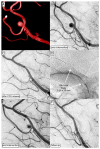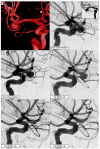Distal Flow Diversion with Anti-Thrombotically Coated and Bare Metal Low-Profile Flow Diverters-A Comparison
- PMID: 37048781
- PMCID: PMC10095446
- DOI: 10.3390/jcm12072700
Distal Flow Diversion with Anti-Thrombotically Coated and Bare Metal Low-Profile Flow Diverters-A Comparison
Abstract
Background and purpose: The establishment of low-profile flow diverting stents (FDS), for example, the Silk Vista Baby (SVB) and the p48MW, facilitated endovascular treatment of peripheral cerebral aneurysms. This study therefore aims to compare the performance and outcomes of the SVB with those of the p48MW HPC, with a special focus on hemodynamic aspects of peripheral segments and bifurcations.
Materials and methods: The study cohort comprises 108 patients, who were either treated with the SVB or the p48MW HPC between June 2018 and April 2021.
Results: Sixty patients received a SVB and forty-eight patients a p48MW HPC. The SVB was used predominantly in the AcomA-complex, and the p48MW HPC in the MCA bifurcation. Immediately after implantation, significant hemodynamic downgrading (OKM A2-A3, B1-B3, C3) was achieved in 60% in the SVB group vs. 75.1% in the p48MW HPC group. At the second follow-up, after an average of 8.8 and 10.9 months, respectively, OKM D1 was observed in 64.4% of the SVB group vs. 27.3% in the p48MW HPC group. Only 1.7% vs. 6.8% of the aneurysms remained morphologically unaltered (OKM A1). Adverse events with persisting neurologic sequalae at last follow-up were largely comparable in both groups (5.0% vs. 4.2%).
Conclusion: Immediately after implantation, the p48MW HPC had a more profound hemodynamic impact than the SVB; however, early complete occlusions were achieved in a greater proportion of lesions after implantation of the uncoated SVB.
Keywords: Silk Vista Baby; coating; flow diversion; low-profile flow diverter; p48MW; small cerebral vessels.
Conflict of interest statement
The authors declare no conflict of interest.
Figures


Similar articles
-
Endovascular treatment of intracranial aneurysms with silk vista baby flow diverter: A systematic review and meta-analysis.Neuroradiol J. 2025 Feb 27:19714009251324324. doi: 10.1177/19714009251324324. Online ahead of print. Neuroradiol J. 2025. PMID: 40016880 Free PMC article. Review.
-
Endovascular Treatment of Intracranial Aneurysms in Small Peripheral Vessel Segments-Efficacy and Intermediate Follow-Up Results of Flow Diversion With the Silk Vista Baby Low-Profile Flow Diverter.Front Neurol. 2021 May 28;12:671915. doi: 10.3389/fneur.2021.671915. eCollection 2021. Front Neurol. 2021. PMID: 34122317 Free PMC article.
-
Single-Center Experience With the Bare p48MW Low-Profile Flow Diverter and Its Hydrophilically Covered Version for Treatment of Bifurcation Aneurysms in Distal Segments of the Anterior and Posterior Circulation.Front Neurol. 2020 Sep 23;11:1050. doi: 10.3389/fneur.2020.01050. eCollection 2020. Front Neurol. 2020. PMID: 33071937 Free PMC article.
-
First Experience of Three Neurovascular Centers With the p64MW-HPC, a Low-Profile Flow Diverter Designed for Proximal Cerebral Vessels With Antithrombotic Coating.Front Neurol. 2021 Sep 14;12:724705. doi: 10.3389/fneur.2021.724705. eCollection 2021. Front Neurol. 2021. PMID: 34594297 Free PMC article.
-
Distal anterior cerebral artery aneurysms treated with flow diversion: experience of a large-volume center and systematic review of the literature.J Neurointerv Surg. 2021 Jan;13(1):42-48. doi: 10.1136/neurintsurg-2020-015980. Epub 2020 May 26. J Neurointerv Surg. 2021. PMID: 32457222
Cited by
-
Endovascular treatment of intracranial aneurysms with silk vista baby flow diverter: A systematic review and meta-analysis.Neuroradiol J. 2025 Feb 27:19714009251324324. doi: 10.1177/19714009251324324. Online ahead of print. Neuroradiol J. 2025. PMID: 40016880 Free PMC article. Review.
-
Classification of anatomy and treatment approaches for aneurysms originating from the proximal of the A1 segment of the anterior cerebral artery in clinical settings.Front Neurol. 2024 Jul 23;15:1369414. doi: 10.3389/fneur.2024.1369414. eCollection 2024. Front Neurol. 2024. PMID: 39108659 Free PMC article.
-
Managing thrombosis risk in flow diversion: A review of antiplatelet approaches.Neuroradiol J. 2025 Jan 8:19714009251313515. doi: 10.1177/19714009251313515. Online ahead of print. Neuroradiol J. 2025. PMID: 39772903 Free PMC article. Review.
-
A Review of the Current Literature on Cerebral Aneurysms.Cureus. 2025 Mar 7;17(3):e80223. doi: 10.7759/cureus.80223. eCollection 2025 Mar. Cureus. 2025. PMID: 40190974 Free PMC article. Review.
References
-
- Schob S., Brill R., Siebert E., Sponza M., Schüngel M.-S., Wohlgemuth W.A., Götz N., Mucha D., Gopinathan A., Scheer M., et al. Indirect Flow Diversion for Off-Centered Bifurcation Aneurysms and Distant Small-Vessel Aneurysms, a Retrospective Proof of Concept Study From Five Neurovascular Centers. Front. Neurol. 2022;12:801470. doi: 10.3389/fneur.2021.801470. - DOI - PMC - PubMed
-
- Maybaum J., Henkes H., Aguilar-Pérez M., Hellstern V., Gihr G.A., Härtig W., Reisberg A., Mucha D., Schüngel M.-S., Brill R., et al. Flow Diversion for Reconstruction of Intradural Vertebral Artery Dissecting Aneurysms Causing Subarachnoid Hemorrhage-A Retrospective Study From Four Neurovascular Centers. Front. Neurol. 2021;12:700164. doi: 10.3389/fneur.2021.700164. - DOI - PMC - PubMed
LinkOut - more resources
Full Text Sources
Research Materials
Miscellaneous

